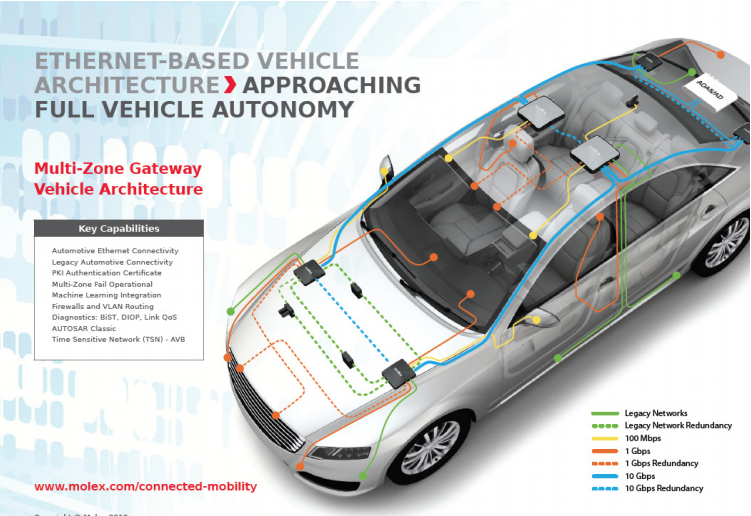BY JOE STENGER, GLOBAL PRODUCT MANAGER, IN-VEHICLE NETWORKING, GATEWAY AND SWITCH SOLUTIONS, MOLEX AND ALEX BORMUTH, DIRECTOR BUSINESS DEVELOPMENT CONNECTED MOBILITY SOLUTIONS, MOLEX Within a single generation, electronics and processor technology have changed nearly all aspects of our lives—most notably vehicle engineering. The scope of electronics, software and processing power has changed not only how our vehicles operate, but also how we perceive them—more like mobile computers than machines.
According to a McKinsey & Company report, between 2010 and 2016, the number of software lines of code (SLOC) in modern cars expanded by a factor of 15, from 10 million lines to roughly 150 million. Software’s average share of overall vehicle content is expected to grow at a compound annual rate of 11%, climbing from 10% today for a D-segment, or large, car (approximately $1,220) to 30% (around $5,200) in 2030.1 Enormous computing power, bandwidth and speed are required to process the massive amount of data generated by numerous sensors to accommodate the increasing networking and automation of vehicles. 5G mobile network connectivity aims to connect everything around us to a data network that offers the speed and response time necessary to allow full utilization of the capabilities of autonomous vehicles. Semiconductor companies are currently developing new microprocessors that enable data transmission rates with high bandwidths of up to 10 Gbps and more for multi-zone vehicle architectures (Figure 1). This will change vehicles from mobile computers into data centers on wheels and enable autonomous vehicles to make complex decisions in real time.
THE EMERGENCE OF AUTOMOTIVE ETHERNET
With existing automotive networks
insufficient to handle the demands of
future vehicles, Ethernet has emerged as
the most important protocol for highspeed
data transmission. The demands on
data rates are constantly rising, placing
greater importance on multi-layered
security practices and the interfaces
necessary to seamlessly connect
hardware, software and interconnect
cabling systems. Ethernet is a mature,
stable and proven technology that offers
high speeds and safety, enabling it
to become established as a standard.
However, Ethernet architectures must
work under much harsher conditions
in vehicles than in most conventional
Ethernet implementations. Consequently,
such networks must be much more robust
because they are exposed to extreme
temperatures, humidity, water, vibrations
and shocks and must withstand significant
electromagnetic interferences (EMI).
MAKING THE MOVE TO MULTI-ZONE
Distribution of the vehicle’s electronic
and electric devices into several zones
allows older automotive communication
protocols, such as CAN and LIN, and
new standards to be integrated into the
Ethernet-based vehicle architecture.
Special gateways form the interface
between the legacy ECU devices
and the evolving in-vehicle Ethernet
networks, facilitating various protocol
communications into the larger
Ethernet architecture. They aggregate
the sensor data and forward it to one
or more advanced driver assistance
systems (ADAS)/automated driving (AD)
processors, where decisions are made
and the resulting vehicle commands
are transmitted over the high-speed
network to the gateways of the individual
zones. There, the gateways forward
the commands over Ethernet or legacy
networks to the control units.

Figure 1: New microprocessors enable data transmission with high bandwidth up to 10 Gbps or more with multi-zone vehicle architectures. (image source: Molex)
SAFETY IS PRIORITY NO. 1 A wide variety of sensors, such as radar, lidar and high-resolution cameras, constantly collect data on their surroundings and are connected over Ethernet to the gateway. Vehicle engineers will rely on time-sensitive networking (TSN) for interdomain communication and real-time requirements. TSN ensures the desired prioritization of network traffic so that safety-critical functions cannot be blocked by other activities, such as a data stream from the infotainment domain.
In the example of a rearview camera, a signal detecting an object blocking further travel is sent to the gateway over a 100 Mbit Ethernet cable. The gateway aggregates all incoming data into a large data stream and sends it in real time to the ADAS/AD server over a 10 Gbit Ethernet link. There, the software makes a decision about the signal from the rearview camera. A brake command is then sent to the brake control unit, which in turn actuates the brakes to stop the vehicle. Forwarding the signal from the rearview camera is prioritized so that critical functions cannot be interrupted by non-critical network traffic.
The required high safety is achieved by the multi-zone gateway control concept, which uses redundancy to create a failsafe functional network. Plug-and-socket connectors and cables, which are able to provide signal integrity for the entire life of the vehicle, are one of the decisive factors for the reliability of high-speed network connections. Reliability must not be impaired by EMI or by thermal processes. New technologies fulfill this demanding task by combining sensor, control and infotainment data with integrated multi-zone redundancy and TimeSensitive Networking (TSN) capabilities to maximize reliability. A multi-layer safety approach with device certification ensures compliance with the strict safety requirements of vehicle manufacturers.
While automotive Ethernet is expected to “rise and become the backbone of the car,” according to McKinsey, there is growing demand for even higher speeds, and future network systems will be oriented to these increasing speeds. Groups such as the Networking for Autonomous Vehicles (NAV) Alliance and OPEN Alliance are bringing together industry leaders to foster the development and adoption of nextgeneration multi-gig Ethernet automotive networking, as this technology likely represents the future of in-vehicle and V2X connectivity.